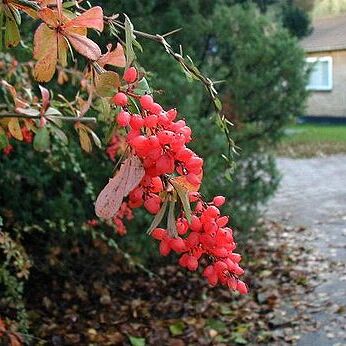Shrubs, semi-evergreen or deciduous, 2-3 m tall. Branches dark brown, sulcate, glabrous; shoots pale brown, slightly puberulous, sparsely black verruculose; spines 3-fid, pale yellow, 8-15 mm. Leaves subsessile or shortly petiolate; leaf blade abaxially pale yellow-green or grayish white, adaxially dark yellow-green, obovate-oblong or obovate, 8-25 × 4-15 mm, subleathery, abaxially with raised midvein, adaxially with slightly impressed midvein, both surfaces with conspicuous reticulate veins, base cuneate, margin 2-8-spinose-serrate on each side, sometimes entire, apex rounded, obtuse, aristate. Inflorescence a congested panicle, 10-30-flowered, 1-2.5 cm, subsessile; bracts slightly longer than pedicels, 1.5-3 mm. Pedicels 1-3 mm; bractlets ovate, ca. 1 mm, apex acute. Sepals in 2 whorls, elliptic; outer sepals ca. 2.5 × 1.8 mm; inner sepals ca. 3.5 × 2.5 mm. Petals obovate, ca. 3.5 × 2 mm, base clawed, with oblong glands, apex emarginate. Stamens 2-2.5 mm; anther connective prolonged, obtuse. Ovules 2, subsessile. Berry red, subglobose or ovoid-globose, 6-7 mm, not pruinose, style persistent. Fl. May-Jun, fr. Jul-Sep.
More
A deciduous shrub. It grows 1.5 m high. It spreads 1.8 m wide. The leaves are oblong. They have teeth at the tip. The leaves are grey-green and 30 mm long. The leaves turn deep red in autumn. The flowers are pale yellow. They are in clusters in the axils of leaves. These are 2.5 cm long. The fruit are red with a grey bloom. They are 6 mm across.

